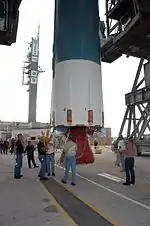RS-27A
The RS-27A is a liquid-fuel rocket engine developed in 1980s by Rocketdyne for use on the first stage of the Delta II and Delta III launch vehicles. It provides 1.05 meganewtons (240,000 lbf) of thrust burning RP-1 and LOX in a gas-generator cycle. The engine is a modified version of its predecessor, the RS-27;[2] its thrust nozzle has been extended to increase its area ratio from 8:1 to 12:1, which provides greater efficiency at altitude.
 RS-27A Engine on Delta II | |
| Country of origin | United States |
|---|---|
| Date | 1989 |
| Designer | Rocketdyne |
| Manufacturer | Rocketdyne, Pratt & Whitney Rocketdyne |
| Application | Booster |
| Predecessor | RS-27 |
| Status | Retired |
| Liquid-fuel engine | |
| Propellant | LOX / RP-1 |
| Cycle | Gas Generator |
| Configuration | |
| Chamber | 1 |
| Performance | |
| Thrust, vacuum | 1,054.2 kN |
| Thrust, sea-level | 890.1 kN (200,102 lbf) |
| Thrust-to-weight ratio | 102.47 |
| Chamber pressure | 4.8MPa (700 psia) |
| Specific impulse, vacuum | 302 seconds (2.96 km/s) |
| Specific impulse, sea-level | 255 seconds (2.50 km/s) |
| Burn time | 265 Sec |
| Dimensions | |
| Length | 3.78 m (12.40 ft) |
| Diameter | 1.70 m (5.58 ft) |
| Dry weight | 1,147 kg (2,528 lb) |
| Used in | |
| Delta 7000, first stage[1] | |
The RS-27A main engine is neither restartable nor throttleable. In addition to its main engine, it includes two vernier engines to provide vehicle roll control during flight.[3] When used as the main booster propulsion system for the Delta II family of launch vehicles, has an operational duration of 265 seconds. The last RS-27A engine was used for the ICESat-2 launch on 15 September, 2018.
References
- Astronautix: RS-27A Engine
- Astronautix: RS-27 Engine
- "RS-27A Engine". purdue.edu. Retrieved May 7, 2023.
